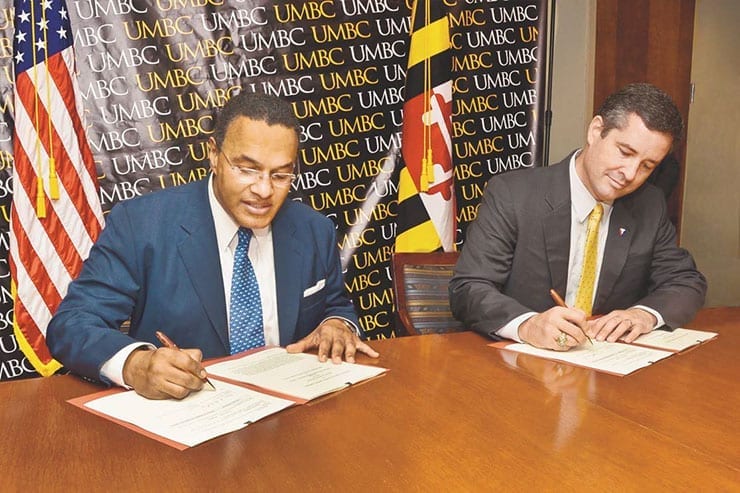The U.S. Army Research, Development and Engineering Command (RDECOM) recently signed a cooperative research agreement (CRADA) with the University of Maryland Baltimore County (UBMC) to spur scientific research in areas of mutual interest.
RDECOM Director Dale A. Ormond said he was impressed with the school’s emphasis on science and engineering as he formalized the CRADA with UMBC President Dr. Freeman A. Hrabowski III. The organizations share a common goal of furthering the boundaries of science and engineering, Ormond said. “I don’t think there’s any discipline you can teach that we don’t use someplace in this command,” Ormond said as he described his workforce of 11,000 scientists and engineers spread across seven organizations.
The formal agreement provides a framework for RDECOM and UMBC researchers to work together on projects while sharing facilities, equipment and other resources. RDECOM now has 263 total CRADAs and 20 with universities.
RDECOM signed CRADAs with two other Maryland institutions – Morgan State University and the University of Maryland College Park — in 2010. Hrabowski discussed his students’ successes and how UMBC and Army researchers will fit together well.
“We have the highest percentage of students in science and engineering in the state,” Hrabowski said. “Almost half are graduating with degrees in science or engineering. Many are interested in working for their country. Large numbers of students at UMBC have families in the military because they retired in this area. They really understand the nobility of the work.”
The agreement now allows the organizations to enter into Joint Work Statements (JWS) that focus on specific topics. After the CRADA signing, Suzanne Milchling, director of program integration at RDECOM’s Edgewood Chemical Biological Center (ECBC), and UMBC Vice President for Research Dr. Karl V. Steiner finalized the first JWS.
ECBC scientists will partner with the university’s chemistry department on developing next-generation systems for detecting hazardous compounds, according to Milchling. UMBC will also be a valuable partner to the command as a large percentage of its workforce nears retirement age, Ormond said.
“Over the next 10 to 15 years, we’re going to have a huge changeover in our workforce. About 50 percent of our scientists and engineers are in their early to mid-50s,” Ormond said. “I need smart, bright people who have STEM degrees to come work for us so we can continue to push the leading edges of science and engineering.”
Ormond extolled the virtues of his employees’ efforts in enabling the success of Soldiers as well as the unique opportunities afforded by working as an Army researcher.
“Once I get a kid into one of our laboratories, they get to do things they could do no place else,” he said. “In the end, they’re all helping a Soldier in the middle of nowhere execute their mission and come home safely. “There’s a tremendous amount of motivation for our scientists and engineers. I argue, in many ways, we more profoundly impact that Soldier’s ability to do that than anyone else.”
Article courtesy of Dan Lafontaine, RDECOM, with edits for length and context.
Image: Dr. Freeman A. Hrabowski III, president of the University of Maryland Baltimore County, and Dale A. Ormond, Director of RDECOM, sign a cooperative research and development agreement June 6 in Baltimore. Credit: Conrad Johnson


